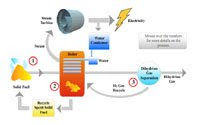Uranium is placed in rods in the reactor's core. Free neutrons are released into the core. When a neutron hits the nucleus of a uranium atom, fission occurs, tremendous amouts of heat are released. When the nucleus was split 2 or 3 neutrons were set free. Those, in turn, split the nuclei of other atoms, setting more neutrons free. A chain reaction takes place in the core creating large amounts of heat. A coolant circulates around the rods of uranium in the core. The most used coolant is water, but newer plants use liquid metal instead.
The coolant is used to keep the reactor from getting too hot. It is also needed in the generation process. The coolant absorbs the heat produced by fission. It travels through tubes until it reaches the steam boiler. Pressure inside the tubes prevents the coolant from boiling. At the steam boiler, the heat from the coolant passes through the tube walls and heats up sea water. The sea water was pumped in from a nearby river or stream. The heated sea water boils into steam. The steam travels through pipes to a turbine. The steam causes a turbine to turn, which then turns a generator to create electricity.
Many scientists have argued about a long term storage for our nuclear waste. Many think the waste should be placed in concrete containers and buried far beneath the Earth's surface. Others say that some of the waste should be loaded into rockets and shot at the sun. Some countries have already decided on their plans. Canada is currently looking at a plan to bury their radioactive waste underneath the Canadian Shield. The United States has a plan to bury their waste underground in Nevada where some nuclear experiments and tests have already been conducted. So far, continuing debates have prevented much of anything from being done about nuclear waste. Unfortunatelly, after buried underground, the nuclear waste can take millions of years to decay.
Problems
Although nuclear power plants have many advantages, they have some major problems. If anything were ever to go wrong inside the reactor, the results could be disasterous. One of the most dangerous difficulties is the possibility of a nuclear meltdown. This occurs when the core overheats in an uncontrolled manner -- the core simply melts. Such an event would release amazing amounts of radioactivity. There are many emergency cooling systems and back-ups to prevent the reactor from getting to meltdown temperatures.


One problem that was not stopped was the incident at Chernobyl. The Chernobyl plant reached 150 times its normal power level. The pressure inside the water holding tubes there became so great that finally the plant just blew itself apart. Poor construction and operation of the power plant caused the disaster. The disaster killed 31 people and 20 square miles of land are now uninhabitable. Some people say that the Chernobyl accident is responsible for many cases of cancer all across Europe. The scientists and environmentalists fighting against nuclear power, use accidents like these as their argument.

The Three Mile Island accident of 1979 was a partial core meltdown in Unit 2 of the nuclear power plant of Three Mile Island Nuclear Generating Station in Dauphin County,Harrisburg, Pennsylvania.It was the most significant accident in the history of the American commercial nuclear power generating industry, resulting in the release of an estimated 43,000 curies of radioactive kyrpton. The accident began on Wednesday, March 28, 1979. However, no deaths or injuries to plant workers or members of the nearby community can be attributed to the accident,and a government report (the "Kemeny Commission Report") concluded that "there will either be no case of cancer or the number of cases will be so small that it will never be possible to detect them. The same conclusion applies to the other possible health effects."

